Health Crisis in Nepal During and After the 2015 Earthquake
VerifiedAdded on 2023/06/07
|14
|5520
|85
AI Summary
This essay highlights the health crisis of Nepal during the earthquake and after the earthquake in the year 2015. It discusses the immediate and medium-term health crises that occurred due to the earthquake and the long-term side effects that were seen. It also talks about the coordination mechanism between national and international actors during the crisis.
Contribute Materials
Your contribution can guide someone’s learning journey. Share your
documents today.

Essay
Secure Best Marks with AI Grader
Need help grading? Try our AI Grader for instant feedback on your assignments.

Contents
INTRODUCTION...........................................................................................................................1
MAIN BODY...................................................................................................................................1
CONCLUSION .............................................................................................................................10
REFERENCES..............................................................................................................................11
INTRODUCTION...........................................................................................................................1
MAIN BODY...................................................................................................................................1
CONCLUSION .............................................................................................................................10
REFERENCES..............................................................................................................................11

INTRODUCTION
The term crisis is defined as either any period or event which will direct to a
dangerous and unstable situation impacting the group, an individual, or all of the country. These
are negative changes in the environment or human affairs, especially when they happen suddenly
with no or little warning. During the period and after the time of crisis, an important and difficult
decision must be taken (Acharya, and et. al., 2022). Nepal country is situated in a mountainous
region across India. High altitude location, heavy monsoon rain, and disturbances in tectonic
plates made the environment of Nepal more vulnerable to natural calamities like wind storms,
heavy rain, flood, earthquake, landslides, etc. In 2015, a 7.6 magnitude earthquake hit Nepal.
Crisis-hit destructed many governmental buildings, residential areas, trekking routes, sporting
facilities, health facilities, schools, heritage sites, agricultural land, hydropower plant, etc. The
occurrence of the earthquake was a result of the prolonged build-up of stress because of which
there was a sudden thrust observed along the Indian Plate. Many multi-story buildings were
toppled in the capital city, Kathmandu (Tachibana et. al., 2019). This essay highlights the health
crisis of Nepal during the earthquake and after the earthquake in the year 2015.
MAIN BODY
A Health crisis is a very complex health system or difficult situation which affects
humans in more or one geographic area, it mainly occurred due to natural hazards. On April 25,
2015, a 7.8 earthquake struck afflict Nepal in Asia. It caused about 9000 human beings' death
and too many thousands more were getting injured. More than six lacs houses or structures were
either destroyed or damaged in Kathmandu and other nearby cities. The earthquake occurred in
Nepal at a depth of about 8.2 km with its epicenter about 34 km east to the southeast of Lamjung
(Social capital in a crisis: NGO responses to 2015). According to the report of the united states
geological survey, the quake was caused through libration of built-up stress or an instant thrust,
along the main wrong line where the Indian plate, taking India, is diving slowly below the
Eurasian plate, taking much of Asia and Europe. Kathmandu is established on a block of crust
about 60 km long and 120 km wide, quickly shifting about 3 meters to the south in just 30
seconds. Since an earthquake can bang instantly without any warning, it is an abrupt and violent
shaking of the earth, that occurred through movement between two tectonic plates along a wrong
1
The term crisis is defined as either any period or event which will direct to a
dangerous and unstable situation impacting the group, an individual, or all of the country. These
are negative changes in the environment or human affairs, especially when they happen suddenly
with no or little warning. During the period and after the time of crisis, an important and difficult
decision must be taken (Acharya, and et. al., 2022). Nepal country is situated in a mountainous
region across India. High altitude location, heavy monsoon rain, and disturbances in tectonic
plates made the environment of Nepal more vulnerable to natural calamities like wind storms,
heavy rain, flood, earthquake, landslides, etc. In 2015, a 7.6 magnitude earthquake hit Nepal.
Crisis-hit destructed many governmental buildings, residential areas, trekking routes, sporting
facilities, health facilities, schools, heritage sites, agricultural land, hydropower plant, etc. The
occurrence of the earthquake was a result of the prolonged build-up of stress because of which
there was a sudden thrust observed along the Indian Plate. Many multi-story buildings were
toppled in the capital city, Kathmandu (Tachibana et. al., 2019). This essay highlights the health
crisis of Nepal during the earthquake and after the earthquake in the year 2015.
MAIN BODY
A Health crisis is a very complex health system or difficult situation which affects
humans in more or one geographic area, it mainly occurred due to natural hazards. On April 25,
2015, a 7.8 earthquake struck afflict Nepal in Asia. It caused about 9000 human beings' death
and too many thousands more were getting injured. More than six lacs houses or structures were
either destroyed or damaged in Kathmandu and other nearby cities. The earthquake occurred in
Nepal at a depth of about 8.2 km with its epicenter about 34 km east to the southeast of Lamjung
(Social capital in a crisis: NGO responses to 2015). According to the report of the united states
geological survey, the quake was caused through libration of built-up stress or an instant thrust,
along the main wrong line where the Indian plate, taking India, is diving slowly below the
Eurasian plate, taking much of Asia and Europe. Kathmandu is established on a block of crust
about 60 km long and 120 km wide, quickly shifting about 3 meters to the south in just 30
seconds. Since an earthquake can bang instantly without any warning, it is an abrupt and violent
shaking of the earth, that occurred through movement between two tectonic plates along a wrong
1

line in the crust of the earth (Adhikari, and et. al., 2021). It can result in soil liquefaction,
fissures, ground shaking, landslides, tsunamis, avalanches, and fires.
The degree of harm and destruction caused due to the quakes depends on intensity and
duration, local geology, magnitude, the risk-management action present in the place, industrial
plant, and building materials and designs, and the time of the day that it occurs. Health threats
that occur due to the earthquakes can be diverse as the nature of the environment built (like
urban slums and poor housing), the secondary effects of the earthquake-like landslides and
tsunamis, and the strength of the earthquake. In Nepal, the earthquake crisis of 2015 had
immediate impacts on health involve: trauma-related injuries and death due to the building
destruction or collapse, trauma-related injuries and deaths by the secondary effect of the quake,
such as landslides, and many more (Baral, 2020). In Nepal due to the crisis that occurred in
2015, many medium-term health crises occur which include: (1) Untreated wounds and
secondary infection. (2) Enhanced morbidity and risk of complexity related to childbirth and
pregnancy due to neonatal and interrupted obstetric services. (3) Very high risk of infective
diseases, especially in those areas which are overcrowded. (4) Enhanced morbidity and risk of
issues of chronic illness because of interruption of diagnosis and treatment. (5) Enhanced
psychosocial requirements. (6) very high environmental contamination occurred due to
radiological and chemical agents following industrial infrastructure destruction. The earthquake
in Nepal also damaged the transportation and health care facilities, which disrupted access to
care and health service delivery. Health workers were not able to reach the facilities of health
which were still functional and supplies of medical had been lost due to the earthquake crisis in
Nepal.
Nepal was enhancing trend due to the activities of humans and less sufficient proactive
legislation. The weakest infrastructure found in Nepal became the major cause of damage to
buildings and injuries or death of a human in an earthquake. Nepal earthquakes are evident that
the quake has long-term and immediate impacts on the health of humans (Jang, Lee, S. and Kim,
2020). After the earthquakes, Nepal had to face several problems which show harmful effects on
the health of people such as earth movement and landslides can cause items to shift, fires to start,
and many more due to which drastically changes occur in the surrounding environment. It caused
acute disease, emotional trauma, and physical trauma. Apart from this, it increased the mortality
and morbidity related to infectious and chronic diseases by the impact on the health care system.
2
fissures, ground shaking, landslides, tsunamis, avalanches, and fires.
The degree of harm and destruction caused due to the quakes depends on intensity and
duration, local geology, magnitude, the risk-management action present in the place, industrial
plant, and building materials and designs, and the time of the day that it occurs. Health threats
that occur due to the earthquakes can be diverse as the nature of the environment built (like
urban slums and poor housing), the secondary effects of the earthquake-like landslides and
tsunamis, and the strength of the earthquake. In Nepal, the earthquake crisis of 2015 had
immediate impacts on health involve: trauma-related injuries and death due to the building
destruction or collapse, trauma-related injuries and deaths by the secondary effect of the quake,
such as landslides, and many more (Baral, 2020). In Nepal due to the crisis that occurred in
2015, many medium-term health crises occur which include: (1) Untreated wounds and
secondary infection. (2) Enhanced morbidity and risk of complexity related to childbirth and
pregnancy due to neonatal and interrupted obstetric services. (3) Very high risk of infective
diseases, especially in those areas which are overcrowded. (4) Enhanced morbidity and risk of
issues of chronic illness because of interruption of diagnosis and treatment. (5) Enhanced
psychosocial requirements. (6) very high environmental contamination occurred due to
radiological and chemical agents following industrial infrastructure destruction. The earthquake
in Nepal also damaged the transportation and health care facilities, which disrupted access to
care and health service delivery. Health workers were not able to reach the facilities of health
which were still functional and supplies of medical had been lost due to the earthquake crisis in
Nepal.
Nepal was enhancing trend due to the activities of humans and less sufficient proactive
legislation. The weakest infrastructure found in Nepal became the major cause of damage to
buildings and injuries or death of a human in an earthquake. Nepal earthquakes are evident that
the quake has long-term and immediate impacts on the health of humans (Jang, Lee, S. and Kim,
2020). After the earthquakes, Nepal had to face several problems which show harmful effects on
the health of people such as earth movement and landslides can cause items to shift, fires to start,
and many more due to which drastically changes occur in the surrounding environment. It caused
acute disease, emotional trauma, and physical trauma. Apart from this, it increased the mortality
and morbidity related to infectious and chronic diseases by the impact on the health care system.
2
Secure Best Marks with AI Grader
Need help grading? Try our AI Grader for instant feedback on your assignments.
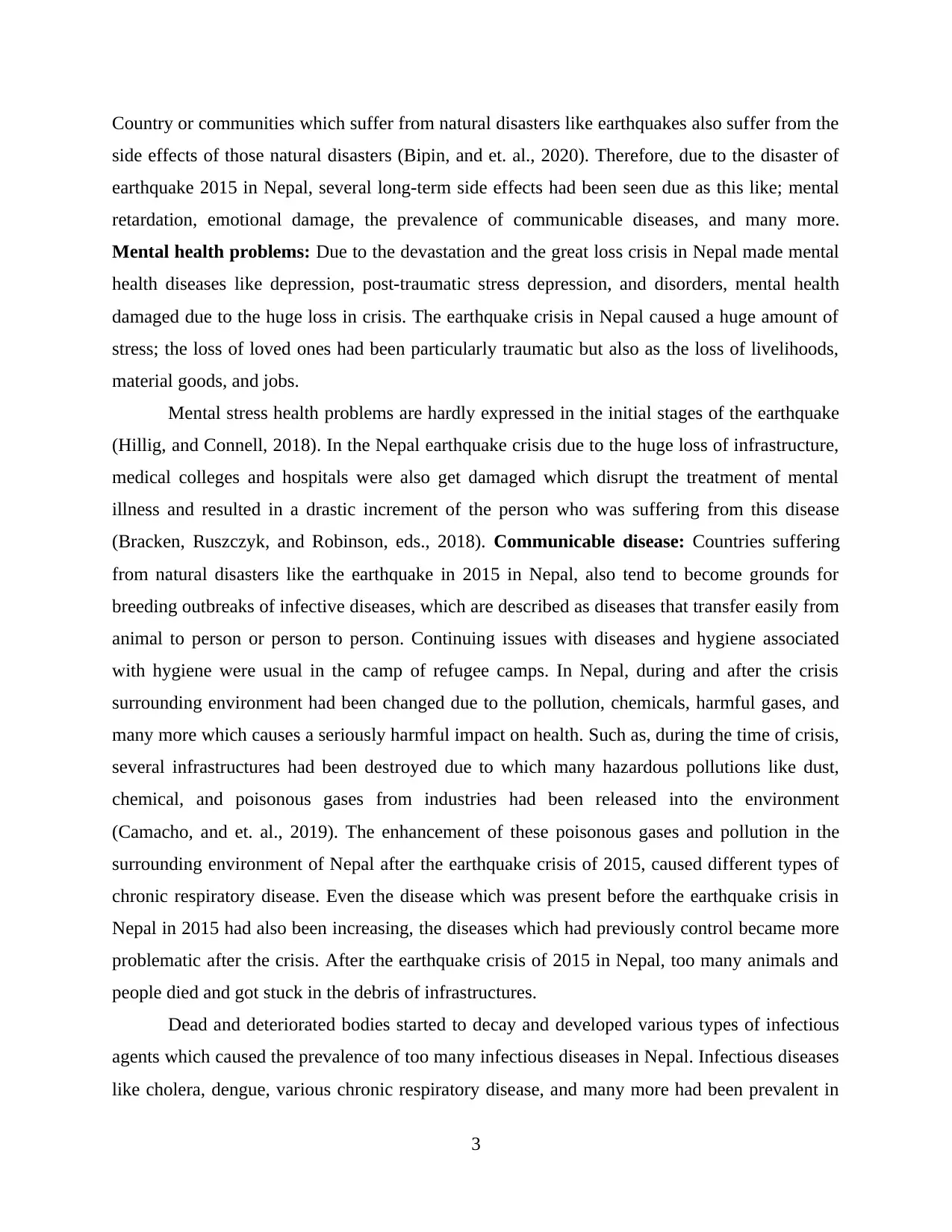
Country or communities which suffer from natural disasters like earthquakes also suffer from the
side effects of those natural disasters (Bipin, and et. al., 2020). Therefore, due to the disaster of
earthquake 2015 in Nepal, several long-term side effects had been seen due as this like; mental
retardation, emotional damage, the prevalence of communicable diseases, and many more.
Mental health problems: Due to the devastation and the great loss crisis in Nepal made mental
health diseases like depression, post-traumatic stress depression, and disorders, mental health
damaged due to the huge loss in crisis. The earthquake crisis in Nepal caused a huge amount of
stress; the loss of loved ones had been particularly traumatic but also as the loss of livelihoods,
material goods, and jobs.
Mental stress health problems are hardly expressed in the initial stages of the earthquake
(Hillig, and Connell, 2018). In the Nepal earthquake crisis due to the huge loss of infrastructure,
medical colleges and hospitals were also get damaged which disrupt the treatment of mental
illness and resulted in a drastic increment of the person who was suffering from this disease
(Bracken, Ruszczyk, and Robinson, eds., 2018). Communicable disease: Countries suffering
from natural disasters like the earthquake in 2015 in Nepal, also tend to become grounds for
breeding outbreaks of infective diseases, which are described as diseases that transfer easily from
animal to person or person to person. Continuing issues with diseases and hygiene associated
with hygiene were usual in the camp of refugee camps. In Nepal, during and after the crisis
surrounding environment had been changed due to the pollution, chemicals, harmful gases, and
many more which causes a seriously harmful impact on health. Such as, during the time of crisis,
several infrastructures had been destroyed due to which many hazardous pollutions like dust,
chemical, and poisonous gases from industries had been released into the environment
(Camacho, and et. al., 2019). The enhancement of these poisonous gases and pollution in the
surrounding environment of Nepal after the earthquake crisis of 2015, caused different types of
chronic respiratory disease. Even the disease which was present before the earthquake crisis in
Nepal in 2015 had also been increasing, the diseases which had previously control became more
problematic after the crisis. After the earthquake crisis of 2015 in Nepal, too many animals and
people died and got stuck in the debris of infrastructures.
Dead and deteriorated bodies started to decay and developed various types of infectious
agents which caused the prevalence of too many infectious diseases in Nepal. Infectious diseases
like cholera, dengue, various chronic respiratory disease, and many more had been prevalent in
3
side effects of those natural disasters (Bipin, and et. al., 2020). Therefore, due to the disaster of
earthquake 2015 in Nepal, several long-term side effects had been seen due as this like; mental
retardation, emotional damage, the prevalence of communicable diseases, and many more.
Mental health problems: Due to the devastation and the great loss crisis in Nepal made mental
health diseases like depression, post-traumatic stress depression, and disorders, mental health
damaged due to the huge loss in crisis. The earthquake crisis in Nepal caused a huge amount of
stress; the loss of loved ones had been particularly traumatic but also as the loss of livelihoods,
material goods, and jobs.
Mental stress health problems are hardly expressed in the initial stages of the earthquake
(Hillig, and Connell, 2018). In the Nepal earthquake crisis due to the huge loss of infrastructure,
medical colleges and hospitals were also get damaged which disrupt the treatment of mental
illness and resulted in a drastic increment of the person who was suffering from this disease
(Bracken, Ruszczyk, and Robinson, eds., 2018). Communicable disease: Countries suffering
from natural disasters like the earthquake in 2015 in Nepal, also tend to become grounds for
breeding outbreaks of infective diseases, which are described as diseases that transfer easily from
animal to person or person to person. Continuing issues with diseases and hygiene associated
with hygiene were usual in the camp of refugee camps. In Nepal, during and after the crisis
surrounding environment had been changed due to the pollution, chemicals, harmful gases, and
many more which causes a seriously harmful impact on health. Such as, during the time of crisis,
several infrastructures had been destroyed due to which many hazardous pollutions like dust,
chemical, and poisonous gases from industries had been released into the environment
(Camacho, and et. al., 2019). The enhancement of these poisonous gases and pollution in the
surrounding environment of Nepal after the earthquake crisis of 2015, caused different types of
chronic respiratory disease. Even the disease which was present before the earthquake crisis in
Nepal in 2015 had also been increasing, the diseases which had previously control became more
problematic after the crisis. After the earthquake crisis of 2015 in Nepal, too many animals and
people died and got stuck in the debris of infrastructures.
Dead and deteriorated bodies started to decay and developed various types of infectious
agents which caused the prevalence of too many infectious diseases in Nepal. Infectious diseases
like cholera, dengue, various chronic respiratory disease, and many more had been prevalent in
3
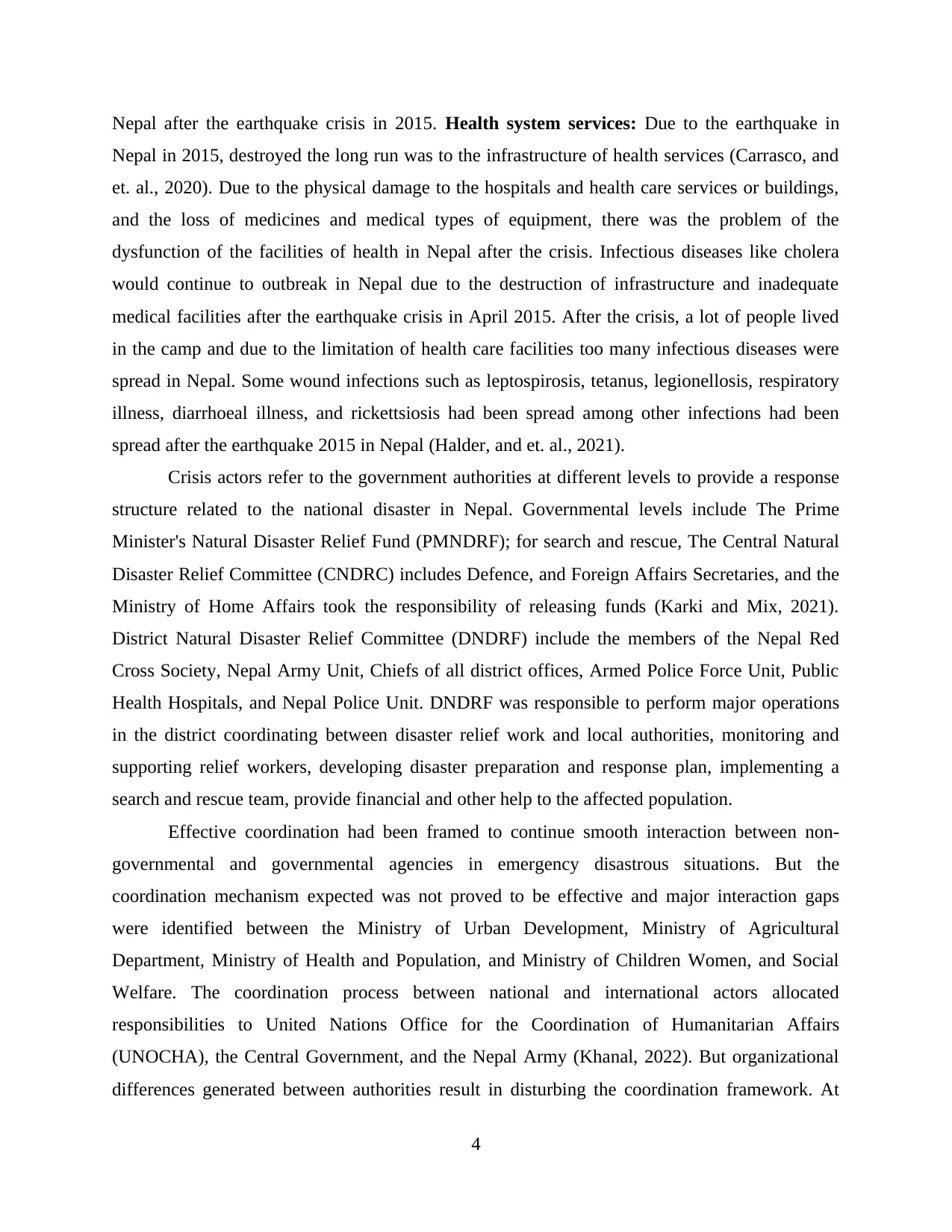
Nepal after the earthquake crisis in 2015. Health system services: Due to the earthquake in
Nepal in 2015, destroyed the long run was to the infrastructure of health services (Carrasco, and
et. al., 2020). Due to the physical damage to the hospitals and health care services or buildings,
and the loss of medicines and medical types of equipment, there was the problem of the
dysfunction of the facilities of health in Nepal after the crisis. Infectious diseases like cholera
would continue to outbreak in Nepal due to the destruction of infrastructure and inadequate
medical facilities after the earthquake crisis in April 2015. After the crisis, a lot of people lived
in the camp and due to the limitation of health care facilities too many infectious diseases were
spread in Nepal. Some wound infections such as leptospirosis, tetanus, legionellosis, respiratory
illness, diarrhoeal illness, and rickettsiosis had been spread among other infections had been
spread after the earthquake 2015 in Nepal (Halder, and et. al., 2021).
Crisis actors refer to the government authorities at different levels to provide a response
structure related to the national disaster in Nepal. Governmental levels include The Prime
Minister's Natural Disaster Relief Fund (PMNDRF); for search and rescue, The Central Natural
Disaster Relief Committee (CNDRC) includes Defence, and Foreign Affairs Secretaries, and the
Ministry of Home Affairs took the responsibility of releasing funds (Karki and Mix, 2021).
District Natural Disaster Relief Committee (DNDRF) include the members of the Nepal Red
Cross Society, Nepal Army Unit, Chiefs of all district offices, Armed Police Force Unit, Public
Health Hospitals, and Nepal Police Unit. DNDRF was responsible to perform major operations
in the district coordinating between disaster relief work and local authorities, monitoring and
supporting relief workers, developing disaster preparation and response plan, implementing a
search and rescue team, provide financial and other help to the affected population.
Effective coordination had been framed to continue smooth interaction between non-
governmental and governmental agencies in emergency disastrous situations. But the
coordination mechanism expected was not proved to be effective and major interaction gaps
were identified between the Ministry of Urban Development, Ministry of Agricultural
Department, Ministry of Health and Population, and Ministry of Children Women, and Social
Welfare. The coordination process between national and international actors allocated
responsibilities to United Nations Office for the Coordination of Humanitarian Affairs
(UNOCHA), the Central Government, and the Nepal Army (Khanal, 2022). But organizational
differences generated between authorities result in disturbing the coordination framework. At
4
Nepal in 2015, destroyed the long run was to the infrastructure of health services (Carrasco, and
et. al., 2020). Due to the physical damage to the hospitals and health care services or buildings,
and the loss of medicines and medical types of equipment, there was the problem of the
dysfunction of the facilities of health in Nepal after the crisis. Infectious diseases like cholera
would continue to outbreak in Nepal due to the destruction of infrastructure and inadequate
medical facilities after the earthquake crisis in April 2015. After the crisis, a lot of people lived
in the camp and due to the limitation of health care facilities too many infectious diseases were
spread in Nepal. Some wound infections such as leptospirosis, tetanus, legionellosis, respiratory
illness, diarrhoeal illness, and rickettsiosis had been spread among other infections had been
spread after the earthquake 2015 in Nepal (Halder, and et. al., 2021).
Crisis actors refer to the government authorities at different levels to provide a response
structure related to the national disaster in Nepal. Governmental levels include The Prime
Minister's Natural Disaster Relief Fund (PMNDRF); for search and rescue, The Central Natural
Disaster Relief Committee (CNDRC) includes Defence, and Foreign Affairs Secretaries, and the
Ministry of Home Affairs took the responsibility of releasing funds (Karki and Mix, 2021).
District Natural Disaster Relief Committee (DNDRF) include the members of the Nepal Red
Cross Society, Nepal Army Unit, Chiefs of all district offices, Armed Police Force Unit, Public
Health Hospitals, and Nepal Police Unit. DNDRF was responsible to perform major operations
in the district coordinating between disaster relief work and local authorities, monitoring and
supporting relief workers, developing disaster preparation and response plan, implementing a
search and rescue team, provide financial and other help to the affected population.
Effective coordination had been framed to continue smooth interaction between non-
governmental and governmental agencies in emergency disastrous situations. But the
coordination mechanism expected was not proved to be effective and major interaction gaps
were identified between the Ministry of Urban Development, Ministry of Agricultural
Department, Ministry of Health and Population, and Ministry of Children Women, and Social
Welfare. The coordination process between national and international actors allocated
responsibilities to United Nations Office for the Coordination of Humanitarian Affairs
(UNOCHA), the Central Government, and the Nepal Army (Khanal, 2022). But organizational
differences generated between authorities result in disturbing the coordination framework. At
4
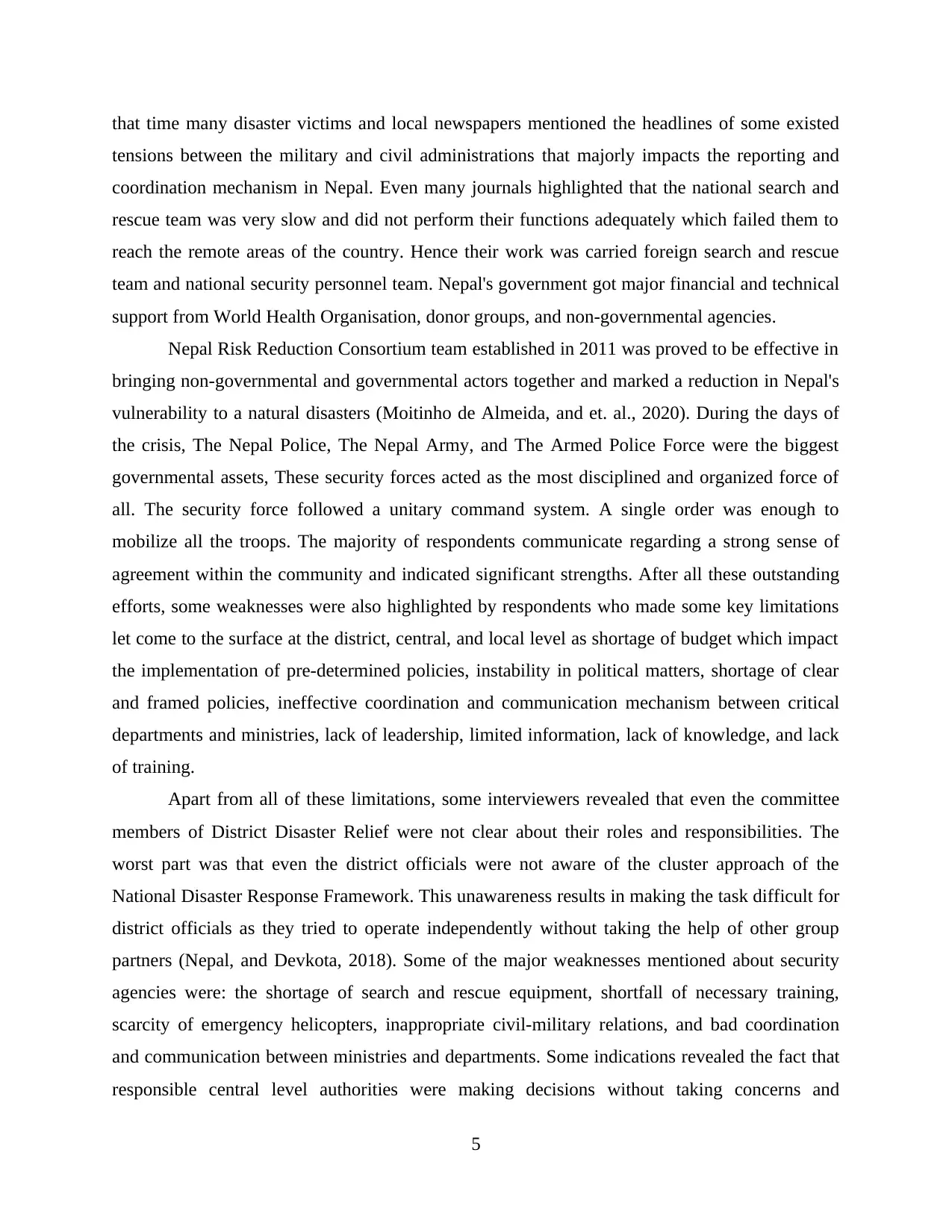
that time many disaster victims and local newspapers mentioned the headlines of some existed
tensions between the military and civil administrations that majorly impacts the reporting and
coordination mechanism in Nepal. Even many journals highlighted that the national search and
rescue team was very slow and did not perform their functions adequately which failed them to
reach the remote areas of the country. Hence their work was carried foreign search and rescue
team and national security personnel team. Nepal's government got major financial and technical
support from World Health Organisation, donor groups, and non-governmental agencies.
Nepal Risk Reduction Consortium team established in 2011 was proved to be effective in
bringing non-governmental and governmental actors together and marked a reduction in Nepal's
vulnerability to a natural disasters (Moitinho de Almeida, and et. al., 2020). During the days of
the crisis, The Nepal Police, The Nepal Army, and The Armed Police Force were the biggest
governmental assets, These security forces acted as the most disciplined and organized force of
all. The security force followed a unitary command system. A single order was enough to
mobilize all the troops. The majority of respondents communicate regarding a strong sense of
agreement within the community and indicated significant strengths. After all these outstanding
efforts, some weaknesses were also highlighted by respondents who made some key limitations
let come to the surface at the district, central, and local level as shortage of budget which impact
the implementation of pre-determined policies, instability in political matters, shortage of clear
and framed policies, ineffective coordination and communication mechanism between critical
departments and ministries, lack of leadership, limited information, lack of knowledge, and lack
of training.
Apart from all of these limitations, some interviewers revealed that even the committee
members of District Disaster Relief were not clear about their roles and responsibilities. The
worst part was that even the district officials were not aware of the cluster approach of the
National Disaster Response Framework. This unawareness results in making the task difficult for
district officials as they tried to operate independently without taking the help of other group
partners (Nepal, and Devkota, 2018). Some of the major weaknesses mentioned about security
agencies were: the shortage of search and rescue equipment, shortfall of necessary training,
scarcity of emergency helicopters, inappropriate civil-military relations, and bad coordination
and communication between ministries and departments. Some indications revealed the fact that
responsible central level authorities were making decisions without taking concerns and
5
tensions between the military and civil administrations that majorly impacts the reporting and
coordination mechanism in Nepal. Even many journals highlighted that the national search and
rescue team was very slow and did not perform their functions adequately which failed them to
reach the remote areas of the country. Hence their work was carried foreign search and rescue
team and national security personnel team. Nepal's government got major financial and technical
support from World Health Organisation, donor groups, and non-governmental agencies.
Nepal Risk Reduction Consortium team established in 2011 was proved to be effective in
bringing non-governmental and governmental actors together and marked a reduction in Nepal's
vulnerability to a natural disasters (Moitinho de Almeida, and et. al., 2020). During the days of
the crisis, The Nepal Police, The Nepal Army, and The Armed Police Force were the biggest
governmental assets, These security forces acted as the most disciplined and organized force of
all. The security force followed a unitary command system. A single order was enough to
mobilize all the troops. The majority of respondents communicate regarding a strong sense of
agreement within the community and indicated significant strengths. After all these outstanding
efforts, some weaknesses were also highlighted by respondents who made some key limitations
let come to the surface at the district, central, and local level as shortage of budget which impact
the implementation of pre-determined policies, instability in political matters, shortage of clear
and framed policies, ineffective coordination and communication mechanism between critical
departments and ministries, lack of leadership, limited information, lack of knowledge, and lack
of training.
Apart from all of these limitations, some interviewers revealed that even the committee
members of District Disaster Relief were not clear about their roles and responsibilities. The
worst part was that even the district officials were not aware of the cluster approach of the
National Disaster Response Framework. This unawareness results in making the task difficult for
district officials as they tried to operate independently without taking the help of other group
partners (Nepal, and Devkota, 2018). Some of the major weaknesses mentioned about security
agencies were: the shortage of search and rescue equipment, shortfall of necessary training,
scarcity of emergency helicopters, inappropriate civil-military relations, and bad coordination
and communication between ministries and departments. Some indications revealed the fact that
responsible central level authorities were making decisions without taking concerns and
5
Paraphrase This Document
Need a fresh take? Get an instant paraphrase of this document with our AI Paraphraser

feedback from the field level. Many field-level volunteers from District Disaster Relief
Committee and security agencies were in complete favor of the one-door policy framed by the
government. They considered the policy a good move for resolving disputes and establishing
equality. Some key weaknesses that were highlighted in public hospitals include scarcity in inter-
hospital information sharing links, shortfall of convince, financial resources, inappropriate
planning, and improper management of waste (Song, and et. al., 2022).
Medical supplies, deficit disaster management plan, and shortage of ambulances and
well-equipped hospitals. Apart from this a senior medical representative from Heath and
Population ministry that many discrepancies appeared in claims that is, it has been observed that
similar names were registered more than once in variable groups like, in yellow and red zones.
The findings reveal that operations of government agencies and institutional sequences-such as
the District Disaster Relief Committee, public hospitals, Security forces, and the Central Natural
Disaster Relief Committee Under the Ministry of Home Affairs was commendable. Security
forces play their responsibility in saving many lives and also providing relief to many suffering
people (Thapa, Rijal, and Shukuya, 2018). The services provided by trained medical
representatives and disciplined security forces proved the solid support of governmental response
in the days of the crisis. The new Disaster Management Act of Nepal was countersigned by the
parliament in September 2017.
Appropriate measures for crisis management helped in providing useful details to
individuals living in the earthquake-prone area such as Nepal during the year 2015. The
occurrence of earthquakes is associated with multiple health hazards which act as a risk for both
the general public and the recovery workers. Therefore, it becomes essential to design a crisis
management plan to help in the conditions of going through a crisis. It was difficult for people
living in Nepal to resume their normal lives after the occurrence of this particular disaster.
Therefore, the preparation of a comprehensive plan was crucial to ensure the apt utilization of
resources. Mitigation of these hazards along with their control and prevention should be the aim
focus while creating an elaborated crisis management plan. Staying safe during an earthquake
was introduced in Kathmandu to each living in the red zone (Arora, 2022). Management of
health crisis during the occurrence of an earthquake includes securing heavy furniture along with
sharp objects such as mirrors, plants, etc. The flammable and hazardous liquids should be kept
tightly sealed and on the lower shelves of the cabinets. There should be an arrangement of
6
Committee and security agencies were in complete favor of the one-door policy framed by the
government. They considered the policy a good move for resolving disputes and establishing
equality. Some key weaknesses that were highlighted in public hospitals include scarcity in inter-
hospital information sharing links, shortfall of convince, financial resources, inappropriate
planning, and improper management of waste (Song, and et. al., 2022).
Medical supplies, deficit disaster management plan, and shortage of ambulances and
well-equipped hospitals. Apart from this a senior medical representative from Heath and
Population ministry that many discrepancies appeared in claims that is, it has been observed that
similar names were registered more than once in variable groups like, in yellow and red zones.
The findings reveal that operations of government agencies and institutional sequences-such as
the District Disaster Relief Committee, public hospitals, Security forces, and the Central Natural
Disaster Relief Committee Under the Ministry of Home Affairs was commendable. Security
forces play their responsibility in saving many lives and also providing relief to many suffering
people (Thapa, Rijal, and Shukuya, 2018). The services provided by trained medical
representatives and disciplined security forces proved the solid support of governmental response
in the days of the crisis. The new Disaster Management Act of Nepal was countersigned by the
parliament in September 2017.
Appropriate measures for crisis management helped in providing useful details to
individuals living in the earthquake-prone area such as Nepal during the year 2015. The
occurrence of earthquakes is associated with multiple health hazards which act as a risk for both
the general public and the recovery workers. Therefore, it becomes essential to design a crisis
management plan to help in the conditions of going through a crisis. It was difficult for people
living in Nepal to resume their normal lives after the occurrence of this particular disaster.
Therefore, the preparation of a comprehensive plan was crucial to ensure the apt utilization of
resources. Mitigation of these hazards along with their control and prevention should be the aim
focus while creating an elaborated crisis management plan. Staying safe during an earthquake
was introduced in Kathmandu to each living in the red zone (Arora, 2022). Management of
health crisis during the occurrence of an earthquake includes securing heavy furniture along with
sharp objects such as mirrors, plants, etc. The flammable and hazardous liquids should be kept
tightly sealed and on the lower shelves of the cabinets. There should be an arrangement of
6
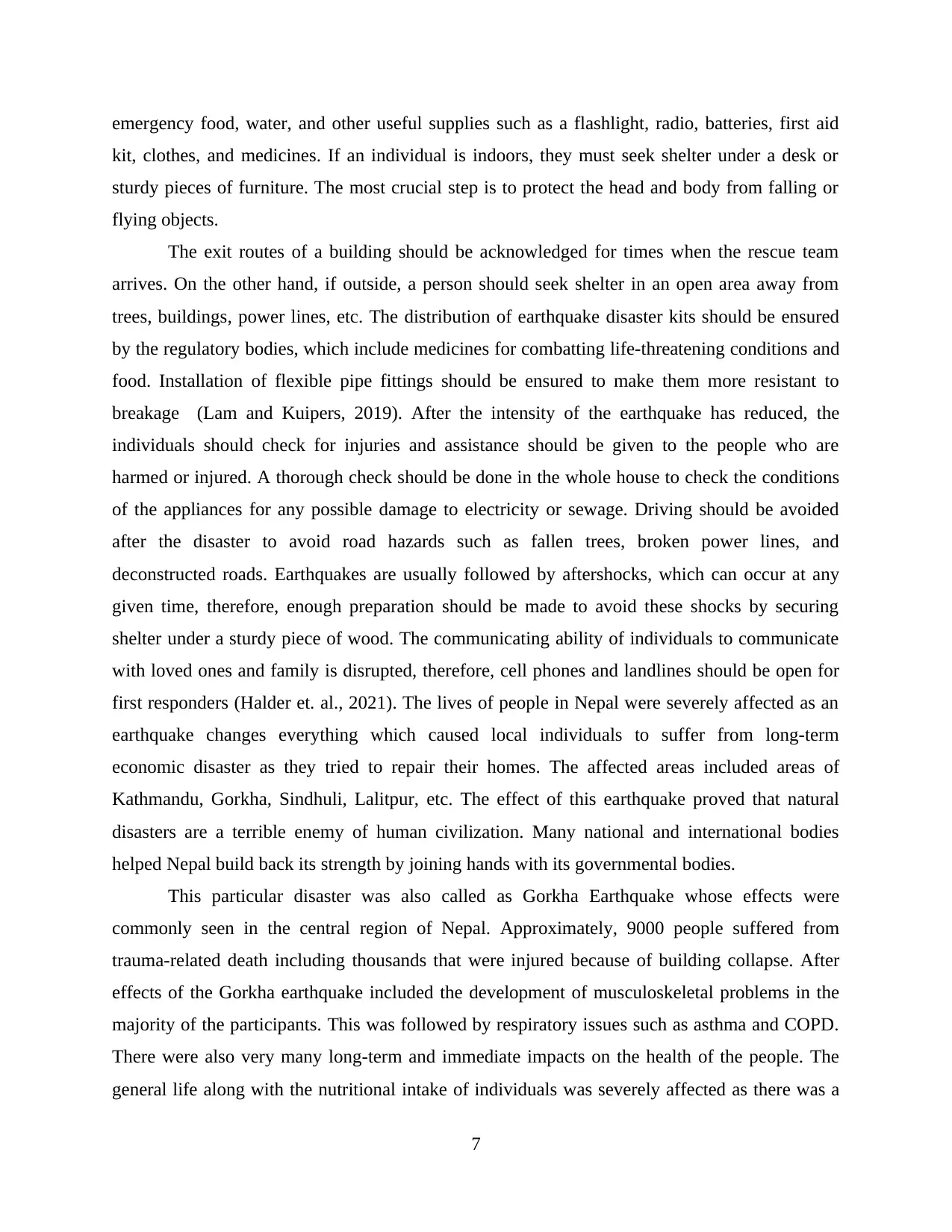
emergency food, water, and other useful supplies such as a flashlight, radio, batteries, first aid
kit, clothes, and medicines. If an individual is indoors, they must seek shelter under a desk or
sturdy pieces of furniture. The most crucial step is to protect the head and body from falling or
flying objects.
The exit routes of a building should be acknowledged for times when the rescue team
arrives. On the other hand, if outside, a person should seek shelter in an open area away from
trees, buildings, power lines, etc. The distribution of earthquake disaster kits should be ensured
by the regulatory bodies, which include medicines for combatting life-threatening conditions and
food. Installation of flexible pipe fittings should be ensured to make them more resistant to
breakage (Lam and Kuipers, 2019). After the intensity of the earthquake has reduced, the
individuals should check for injuries and assistance should be given to the people who are
harmed or injured. A thorough check should be done in the whole house to check the conditions
of the appliances for any possible damage to electricity or sewage. Driving should be avoided
after the disaster to avoid road hazards such as fallen trees, broken power lines, and
deconstructed roads. Earthquakes are usually followed by aftershocks, which can occur at any
given time, therefore, enough preparation should be made to avoid these shocks by securing
shelter under a sturdy piece of wood. The communicating ability of individuals to communicate
with loved ones and family is disrupted, therefore, cell phones and landlines should be open for
first responders (Halder et. al., 2021). The lives of people in Nepal were severely affected as an
earthquake changes everything which caused local individuals to suffer from long-term
economic disaster as they tried to repair their homes. The affected areas included areas of
Kathmandu, Gorkha, Sindhuli, Lalitpur, etc. The effect of this earthquake proved that natural
disasters are a terrible enemy of human civilization. Many national and international bodies
helped Nepal build back its strength by joining hands with its governmental bodies.
This particular disaster was also called as Gorkha Earthquake whose effects were
commonly seen in the central region of Nepal. Approximately, 9000 people suffered from
trauma-related death including thousands that were injured because of building collapse. After
effects of the Gorkha earthquake included the development of musculoskeletal problems in the
majority of the participants. This was followed by respiratory issues such as asthma and COPD.
There were also very many long-term and immediate impacts on the health of the people. The
general life along with the nutritional intake of individuals was severely affected as there was a
7
kit, clothes, and medicines. If an individual is indoors, they must seek shelter under a desk or
sturdy pieces of furniture. The most crucial step is to protect the head and body from falling or
flying objects.
The exit routes of a building should be acknowledged for times when the rescue team
arrives. On the other hand, if outside, a person should seek shelter in an open area away from
trees, buildings, power lines, etc. The distribution of earthquake disaster kits should be ensured
by the regulatory bodies, which include medicines for combatting life-threatening conditions and
food. Installation of flexible pipe fittings should be ensured to make them more resistant to
breakage (Lam and Kuipers, 2019). After the intensity of the earthquake has reduced, the
individuals should check for injuries and assistance should be given to the people who are
harmed or injured. A thorough check should be done in the whole house to check the conditions
of the appliances for any possible damage to electricity or sewage. Driving should be avoided
after the disaster to avoid road hazards such as fallen trees, broken power lines, and
deconstructed roads. Earthquakes are usually followed by aftershocks, which can occur at any
given time, therefore, enough preparation should be made to avoid these shocks by securing
shelter under a sturdy piece of wood. The communicating ability of individuals to communicate
with loved ones and family is disrupted, therefore, cell phones and landlines should be open for
first responders (Halder et. al., 2021). The lives of people in Nepal were severely affected as an
earthquake changes everything which caused local individuals to suffer from long-term
economic disaster as they tried to repair their homes. The affected areas included areas of
Kathmandu, Gorkha, Sindhuli, Lalitpur, etc. The effect of this earthquake proved that natural
disasters are a terrible enemy of human civilization. Many national and international bodies
helped Nepal build back its strength by joining hands with its governmental bodies.
This particular disaster was also called as Gorkha Earthquake whose effects were
commonly seen in the central region of Nepal. Approximately, 9000 people suffered from
trauma-related death including thousands that were injured because of building collapse. After
effects of the Gorkha earthquake included the development of musculoskeletal problems in the
majority of the participants. This was followed by respiratory issues such as asthma and COPD.
There were also very many long-term and immediate impacts on the health of the people. The
general life along with the nutritional intake of individuals was severely affected as there was a
7
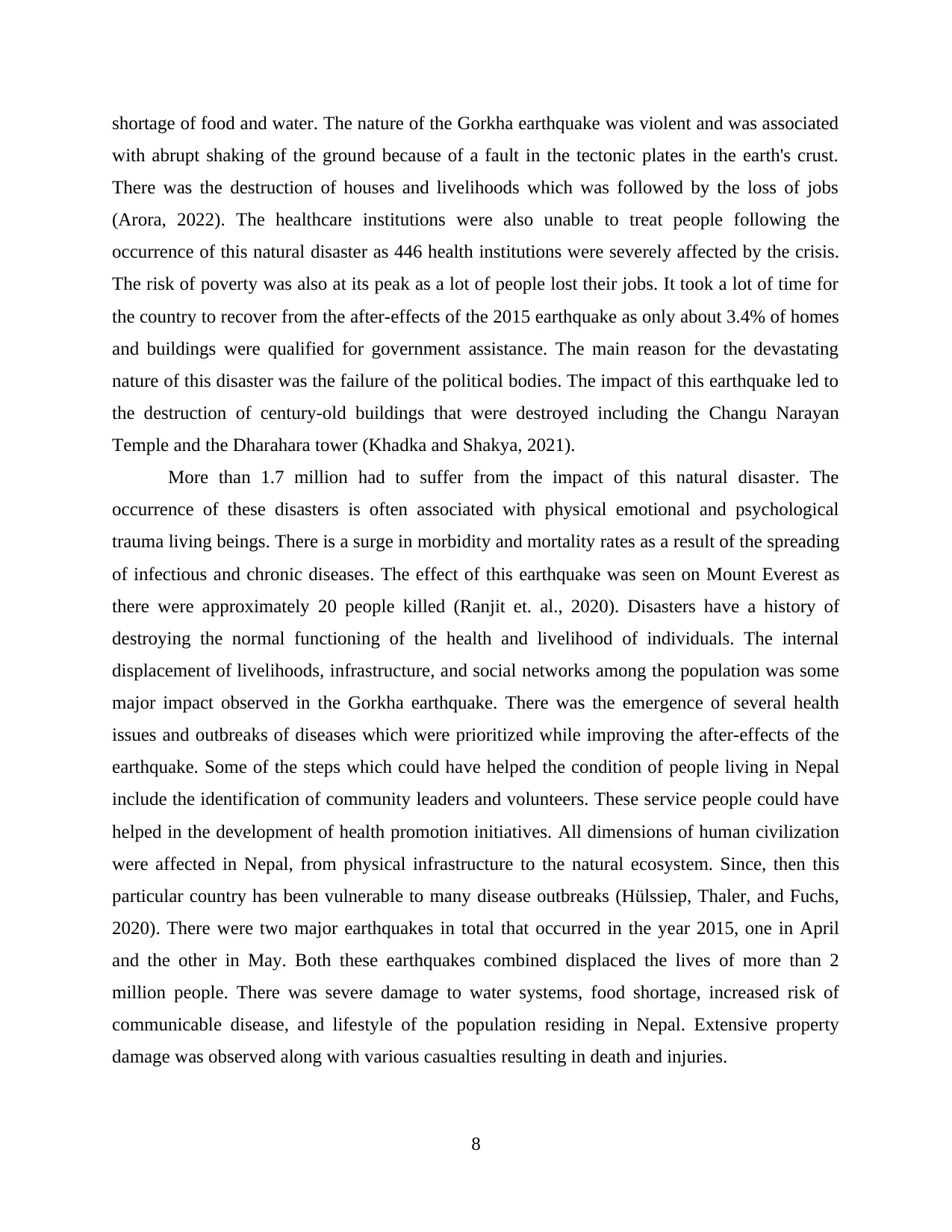
shortage of food and water. The nature of the Gorkha earthquake was violent and was associated
with abrupt shaking of the ground because of a fault in the tectonic plates in the earth's crust.
There was the destruction of houses and livelihoods which was followed by the loss of jobs
(Arora, 2022). The healthcare institutions were also unable to treat people following the
occurrence of this natural disaster as 446 health institutions were severely affected by the crisis.
The risk of poverty was also at its peak as a lot of people lost their jobs. It took a lot of time for
the country to recover from the after-effects of the 2015 earthquake as only about 3.4% of homes
and buildings were qualified for government assistance. The main reason for the devastating
nature of this disaster was the failure of the political bodies. The impact of this earthquake led to
the destruction of century-old buildings that were destroyed including the Changu Narayan
Temple and the Dharahara tower (Khadka and Shakya, 2021).
More than 1.7 million had to suffer from the impact of this natural disaster. The
occurrence of these disasters is often associated with physical emotional and psychological
trauma living beings. There is a surge in morbidity and mortality rates as a result of the spreading
of infectious and chronic diseases. The effect of this earthquake was seen on Mount Everest as
there were approximately 20 people killed (Ranjit et. al., 2020). Disasters have a history of
destroying the normal functioning of the health and livelihood of individuals. The internal
displacement of livelihoods, infrastructure, and social networks among the population was some
major impact observed in the Gorkha earthquake. There was the emergence of several health
issues and outbreaks of diseases which were prioritized while improving the after-effects of the
earthquake. Some of the steps which could have helped the condition of people living in Nepal
include the identification of community leaders and volunteers. These service people could have
helped in the development of health promotion initiatives. All dimensions of human civilization
were affected in Nepal, from physical infrastructure to the natural ecosystem. Since, then this
particular country has been vulnerable to many disease outbreaks (Hülssiep, Thaler, and Fuchs,
2020). There were two major earthquakes in total that occurred in the year 2015, one in April
and the other in May. Both these earthquakes combined displaced the lives of more than 2
million people. There was severe damage to water systems, food shortage, increased risk of
communicable disease, and lifestyle of the population residing in Nepal. Extensive property
damage was observed along with various casualties resulting in death and injuries.
8
with abrupt shaking of the ground because of a fault in the tectonic plates in the earth's crust.
There was the destruction of houses and livelihoods which was followed by the loss of jobs
(Arora, 2022). The healthcare institutions were also unable to treat people following the
occurrence of this natural disaster as 446 health institutions were severely affected by the crisis.
The risk of poverty was also at its peak as a lot of people lost their jobs. It took a lot of time for
the country to recover from the after-effects of the 2015 earthquake as only about 3.4% of homes
and buildings were qualified for government assistance. The main reason for the devastating
nature of this disaster was the failure of the political bodies. The impact of this earthquake led to
the destruction of century-old buildings that were destroyed including the Changu Narayan
Temple and the Dharahara tower (Khadka and Shakya, 2021).
More than 1.7 million had to suffer from the impact of this natural disaster. The
occurrence of these disasters is often associated with physical emotional and psychological
trauma living beings. There is a surge in morbidity and mortality rates as a result of the spreading
of infectious and chronic diseases. The effect of this earthquake was seen on Mount Everest as
there were approximately 20 people killed (Ranjit et. al., 2020). Disasters have a history of
destroying the normal functioning of the health and livelihood of individuals. The internal
displacement of livelihoods, infrastructure, and social networks among the population was some
major impact observed in the Gorkha earthquake. There was the emergence of several health
issues and outbreaks of diseases which were prioritized while improving the after-effects of the
earthquake. Some of the steps which could have helped the condition of people living in Nepal
include the identification of community leaders and volunteers. These service people could have
helped in the development of health promotion initiatives. All dimensions of human civilization
were affected in Nepal, from physical infrastructure to the natural ecosystem. Since, then this
particular country has been vulnerable to many disease outbreaks (Hülssiep, Thaler, and Fuchs,
2020). There were two major earthquakes in total that occurred in the year 2015, one in April
and the other in May. Both these earthquakes combined displaced the lives of more than 2
million people. There was severe damage to water systems, food shortage, increased risk of
communicable disease, and lifestyle of the population residing in Nepal. Extensive property
damage was observed along with various casualties resulting in death and injuries.
8
Secure Best Marks with AI Grader
Need help grading? Try our AI Grader for instant feedback on your assignments.
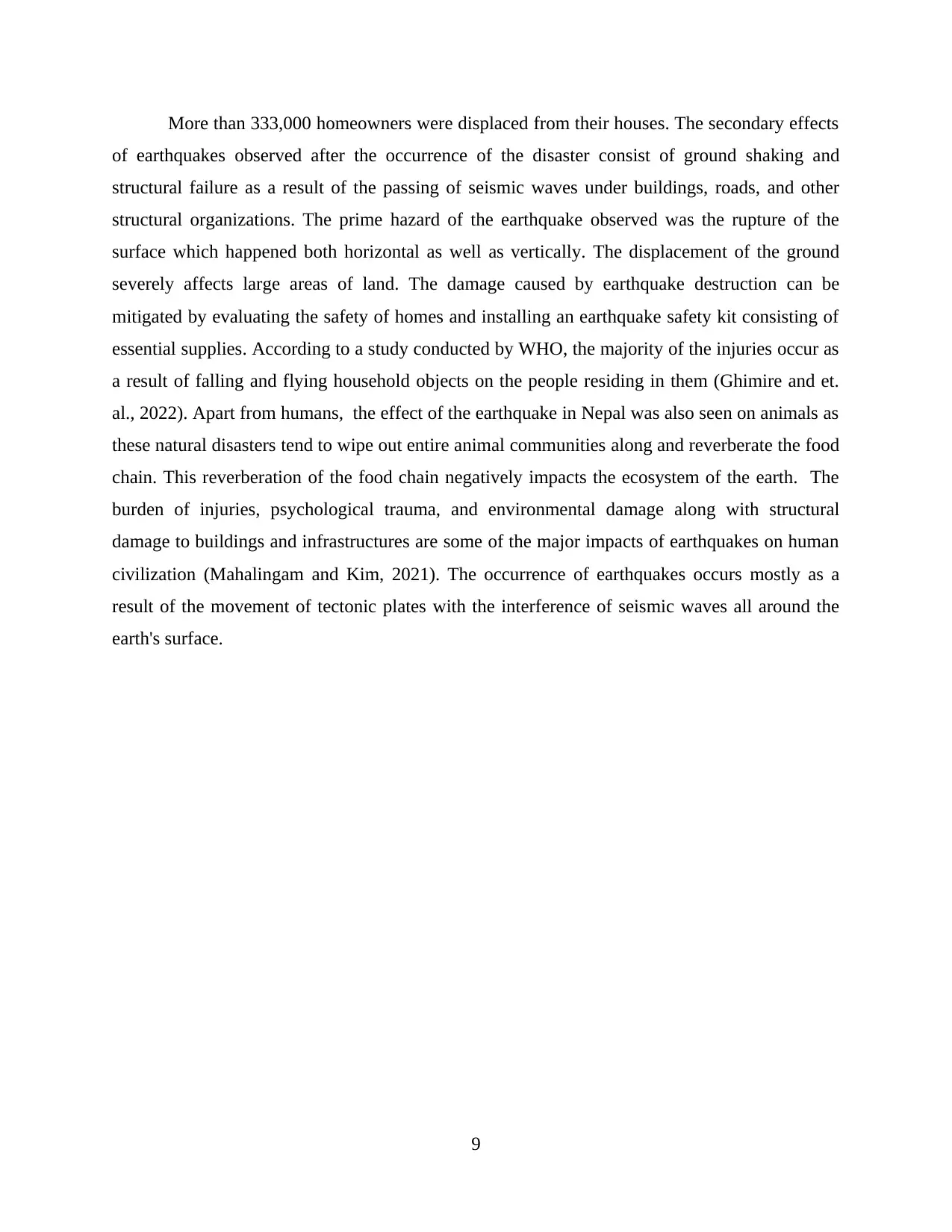
More than 333,000 homeowners were displaced from their houses. The secondary effects
of earthquakes observed after the occurrence of the disaster consist of ground shaking and
structural failure as a result of the passing of seismic waves under buildings, roads, and other
structural organizations. The prime hazard of the earthquake observed was the rupture of the
surface which happened both horizontal as well as vertically. The displacement of the ground
severely affects large areas of land. The damage caused by earthquake destruction can be
mitigated by evaluating the safety of homes and installing an earthquake safety kit consisting of
essential supplies. According to a study conducted by WHO, the majority of the injuries occur as
a result of falling and flying household objects on the people residing in them (Ghimire and et.
al., 2022). Apart from humans, the effect of the earthquake in Nepal was also seen on animals as
these natural disasters tend to wipe out entire animal communities along and reverberate the food
chain. This reverberation of the food chain negatively impacts the ecosystem of the earth. The
burden of injuries, psychological trauma, and environmental damage along with structural
damage to buildings and infrastructures are some of the major impacts of earthquakes on human
civilization (Mahalingam and Kim, 2021). The occurrence of earthquakes occurs mostly as a
result of the movement of tectonic plates with the interference of seismic waves all around the
earth's surface.
9
of earthquakes observed after the occurrence of the disaster consist of ground shaking and
structural failure as a result of the passing of seismic waves under buildings, roads, and other
structural organizations. The prime hazard of the earthquake observed was the rupture of the
surface which happened both horizontal as well as vertically. The displacement of the ground
severely affects large areas of land. The damage caused by earthquake destruction can be
mitigated by evaluating the safety of homes and installing an earthquake safety kit consisting of
essential supplies. According to a study conducted by WHO, the majority of the injuries occur as
a result of falling and flying household objects on the people residing in them (Ghimire and et.
al., 2022). Apart from humans, the effect of the earthquake in Nepal was also seen on animals as
these natural disasters tend to wipe out entire animal communities along and reverberate the food
chain. This reverberation of the food chain negatively impacts the ecosystem of the earth. The
burden of injuries, psychological trauma, and environmental damage along with structural
damage to buildings and infrastructures are some of the major impacts of earthquakes on human
civilization (Mahalingam and Kim, 2021). The occurrence of earthquakes occurs mostly as a
result of the movement of tectonic plates with the interference of seismic waves all around the
earth's surface.
9
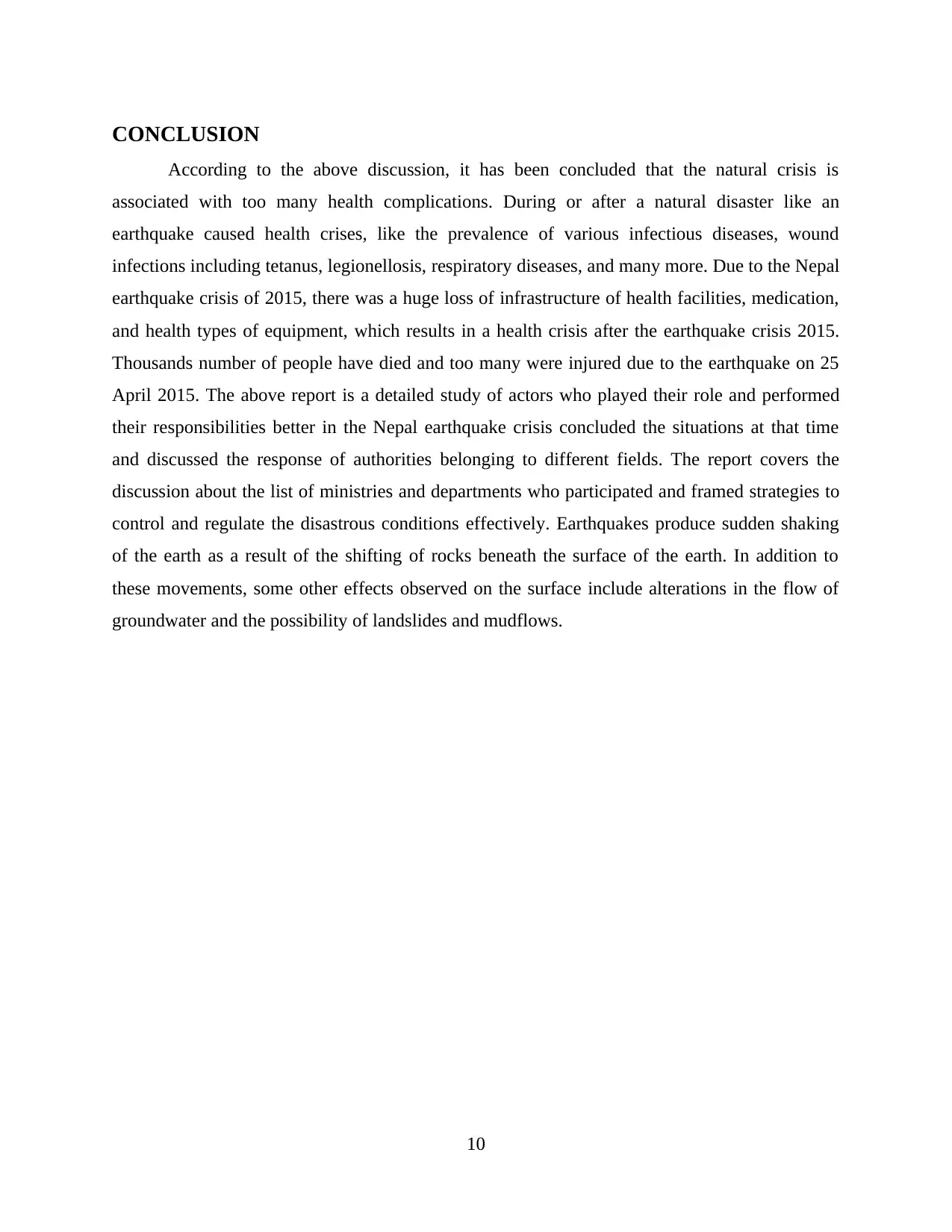
CONCLUSION
According to the above discussion, it has been concluded that the natural crisis is
associated with too many health complications. During or after a natural disaster like an
earthquake caused health crises, like the prevalence of various infectious diseases, wound
infections including tetanus, legionellosis, respiratory diseases, and many more. Due to the Nepal
earthquake crisis of 2015, there was a huge loss of infrastructure of health facilities, medication,
and health types of equipment, which results in a health crisis after the earthquake crisis 2015.
Thousands number of people have died and too many were injured due to the earthquake on 25
April 2015. The above report is a detailed study of actors who played their role and performed
their responsibilities better in the Nepal earthquake crisis concluded the situations at that time
and discussed the response of authorities belonging to different fields. The report covers the
discussion about the list of ministries and departments who participated and framed strategies to
control and regulate the disastrous conditions effectively. Earthquakes produce sudden shaking
of the earth as a result of the shifting of rocks beneath the surface of the earth. In addition to
these movements, some other effects observed on the surface include alterations in the flow of
groundwater and the possibility of landslides and mudflows.
10
According to the above discussion, it has been concluded that the natural crisis is
associated with too many health complications. During or after a natural disaster like an
earthquake caused health crises, like the prevalence of various infectious diseases, wound
infections including tetanus, legionellosis, respiratory diseases, and many more. Due to the Nepal
earthquake crisis of 2015, there was a huge loss of infrastructure of health facilities, medication,
and health types of equipment, which results in a health crisis after the earthquake crisis 2015.
Thousands number of people have died and too many were injured due to the earthquake on 25
April 2015. The above report is a detailed study of actors who played their role and performed
their responsibilities better in the Nepal earthquake crisis concluded the situations at that time
and discussed the response of authorities belonging to different fields. The report covers the
discussion about the list of ministries and departments who participated and framed strategies to
control and regulate the disastrous conditions effectively. Earthquakes produce sudden shaking
of the earth as a result of the shifting of rocks beneath the surface of the earth. In addition to
these movements, some other effects observed on the surface include alterations in the flow of
groundwater and the possibility of landslides and mudflows.
10
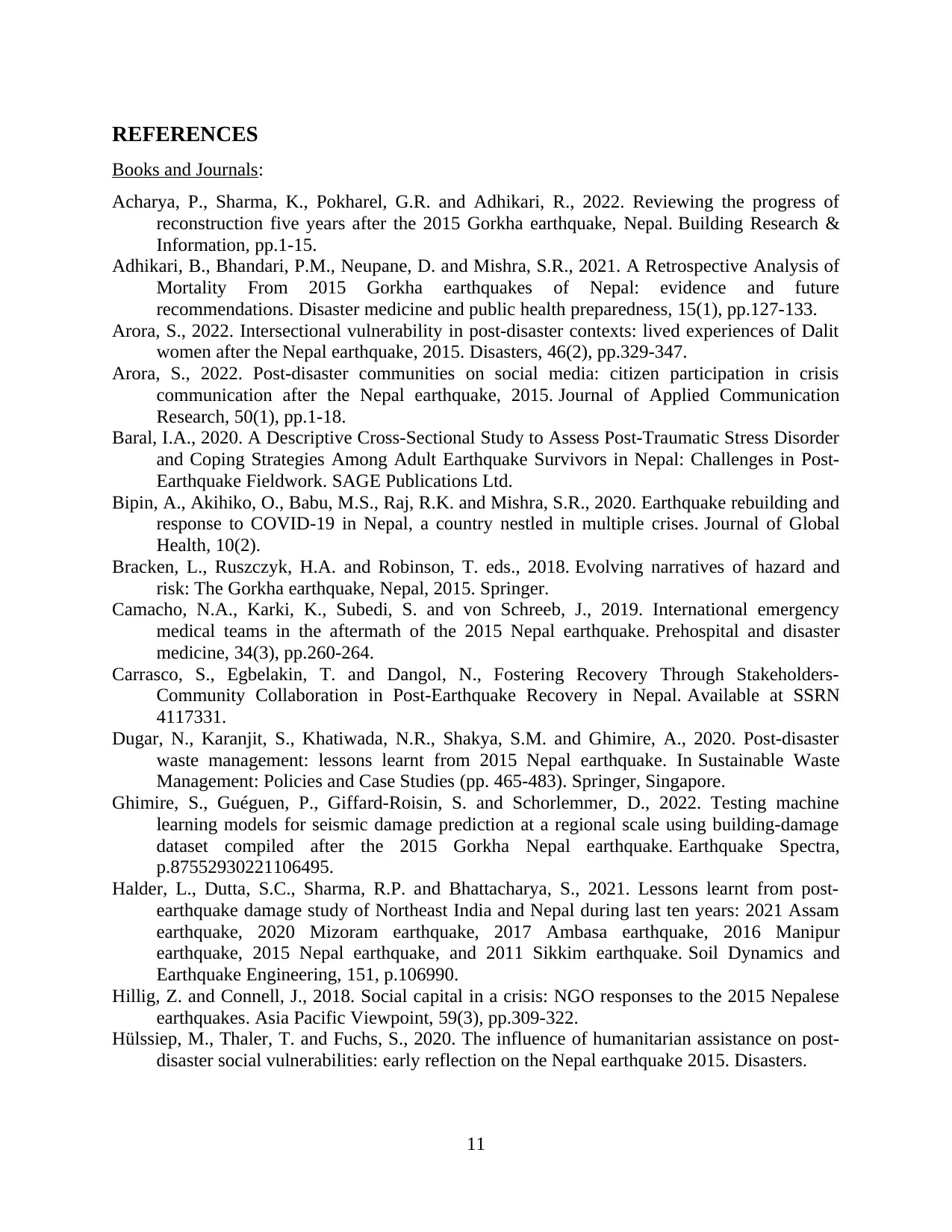
REFERENCES
Books and Journals:
Acharya, P., Sharma, K., Pokharel, G.R. and Adhikari, R., 2022. Reviewing the progress of
reconstruction five years after the 2015 Gorkha earthquake, Nepal. Building Research &
Information, pp.1-15.
Adhikari, B., Bhandari, P.M., Neupane, D. and Mishra, S.R., 2021. A Retrospective Analysis of
Mortality From 2015 Gorkha earthquakes of Nepal: evidence and future
recommendations. Disaster medicine and public health preparedness, 15(1), pp.127-133.
Arora, S., 2022. Intersectional vulnerability in post‐disaster contexts: lived experiences of Dalit
women after the Nepal earthquake, 2015. Disasters, 46(2), pp.329-347.
Arora, S., 2022. Post-disaster communities on social media: citizen participation in crisis
communication after the Nepal earthquake, 2015. Journal of Applied Communication
Research, 50(1), pp.1-18.
Baral, I.A., 2020. A Descriptive Cross-Sectional Study to Assess Post-Traumatic Stress Disorder
and Coping Strategies Among Adult Earthquake Survivors in Nepal: Challenges in Post-
Earthquake Fieldwork. SAGE Publications Ltd.
Bipin, A., Akihiko, O., Babu, M.S., Raj, R.K. and Mishra, S.R., 2020. Earthquake rebuilding and
response to COVID-19 in Nepal, a country nestled in multiple crises. Journal of Global
Health, 10(2).
Bracken, L., Ruszczyk, H.A. and Robinson, T. eds., 2018. Evolving narratives of hazard and
risk: The Gorkha earthquake, Nepal, 2015. Springer.
Camacho, N.A., Karki, K., Subedi, S. and von Schreeb, J., 2019. International emergency
medical teams in the aftermath of the 2015 Nepal earthquake. Prehospital and disaster
medicine, 34(3), pp.260-264.
Carrasco, S., Egbelakin, T. and Dangol, N., Fostering Recovery Through Stakeholders-
Community Collaboration in Post-Earthquake Recovery in Nepal. Available at SSRN
4117331.
Dugar, N., Karanjit, S., Khatiwada, N.R., Shakya, S.M. and Ghimire, A., 2020. Post-disaster
waste management: lessons learnt from 2015 Nepal earthquake. In Sustainable Waste
Management: Policies and Case Studies (pp. 465-483). Springer, Singapore.
Ghimire, S., Guéguen, P., Giffard-Roisin, S. and Schorlemmer, D., 2022. Testing machine
learning models for seismic damage prediction at a regional scale using building-damage
dataset compiled after the 2015 Gorkha Nepal earthquake. Earthquake Spectra,
p.87552930221106495.
Halder, L., Dutta, S.C., Sharma, R.P. and Bhattacharya, S., 2021. Lessons learnt from post-
earthquake damage study of Northeast India and Nepal during last ten years: 2021 Assam
earthquake, 2020 Mizoram earthquake, 2017 Ambasa earthquake, 2016 Manipur
earthquake, 2015 Nepal earthquake, and 2011 Sikkim earthquake. Soil Dynamics and
Earthquake Engineering, 151, p.106990.
Hillig, Z. and Connell, J., 2018. Social capital in a crisis: NGO responses to the 2015 Nepalese
earthquakes. Asia Pacific Viewpoint, 59(3), pp.309-322.
Hülssiep, M., Thaler, T. and Fuchs, S., 2020. The influence of humanitarian assistance on post-
disaster social vulnerabilities: early reflection on the Nepal earthquake 2015. Disasters.
11
Books and Journals:
Acharya, P., Sharma, K., Pokharel, G.R. and Adhikari, R., 2022. Reviewing the progress of
reconstruction five years after the 2015 Gorkha earthquake, Nepal. Building Research &
Information, pp.1-15.
Adhikari, B., Bhandari, P.M., Neupane, D. and Mishra, S.R., 2021. A Retrospective Analysis of
Mortality From 2015 Gorkha earthquakes of Nepal: evidence and future
recommendations. Disaster medicine and public health preparedness, 15(1), pp.127-133.
Arora, S., 2022. Intersectional vulnerability in post‐disaster contexts: lived experiences of Dalit
women after the Nepal earthquake, 2015. Disasters, 46(2), pp.329-347.
Arora, S., 2022. Post-disaster communities on social media: citizen participation in crisis
communication after the Nepal earthquake, 2015. Journal of Applied Communication
Research, 50(1), pp.1-18.
Baral, I.A., 2020. A Descriptive Cross-Sectional Study to Assess Post-Traumatic Stress Disorder
and Coping Strategies Among Adult Earthquake Survivors in Nepal: Challenges in Post-
Earthquake Fieldwork. SAGE Publications Ltd.
Bipin, A., Akihiko, O., Babu, M.S., Raj, R.K. and Mishra, S.R., 2020. Earthquake rebuilding and
response to COVID-19 in Nepal, a country nestled in multiple crises. Journal of Global
Health, 10(2).
Bracken, L., Ruszczyk, H.A. and Robinson, T. eds., 2018. Evolving narratives of hazard and
risk: The Gorkha earthquake, Nepal, 2015. Springer.
Camacho, N.A., Karki, K., Subedi, S. and von Schreeb, J., 2019. International emergency
medical teams in the aftermath of the 2015 Nepal earthquake. Prehospital and disaster
medicine, 34(3), pp.260-264.
Carrasco, S., Egbelakin, T. and Dangol, N., Fostering Recovery Through Stakeholders-
Community Collaboration in Post-Earthquake Recovery in Nepal. Available at SSRN
4117331.
Dugar, N., Karanjit, S., Khatiwada, N.R., Shakya, S.M. and Ghimire, A., 2020. Post-disaster
waste management: lessons learnt from 2015 Nepal earthquake. In Sustainable Waste
Management: Policies and Case Studies (pp. 465-483). Springer, Singapore.
Ghimire, S., Guéguen, P., Giffard-Roisin, S. and Schorlemmer, D., 2022. Testing machine
learning models for seismic damage prediction at a regional scale using building-damage
dataset compiled after the 2015 Gorkha Nepal earthquake. Earthquake Spectra,
p.87552930221106495.
Halder, L., Dutta, S.C., Sharma, R.P. and Bhattacharya, S., 2021. Lessons learnt from post-
earthquake damage study of Northeast India and Nepal during last ten years: 2021 Assam
earthquake, 2020 Mizoram earthquake, 2017 Ambasa earthquake, 2016 Manipur
earthquake, 2015 Nepal earthquake, and 2011 Sikkim earthquake. Soil Dynamics and
Earthquake Engineering, 151, p.106990.
Hillig, Z. and Connell, J., 2018. Social capital in a crisis: NGO responses to the 2015 Nepalese
earthquakes. Asia Pacific Viewpoint, 59(3), pp.309-322.
Hülssiep, M., Thaler, T. and Fuchs, S., 2020. The influence of humanitarian assistance on post-
disaster social vulnerabilities: early reflection on the Nepal earthquake 2015. Disasters.
11
Paraphrase This Document
Need a fresh take? Get an instant paraphrase of this document with our AI Paraphraser
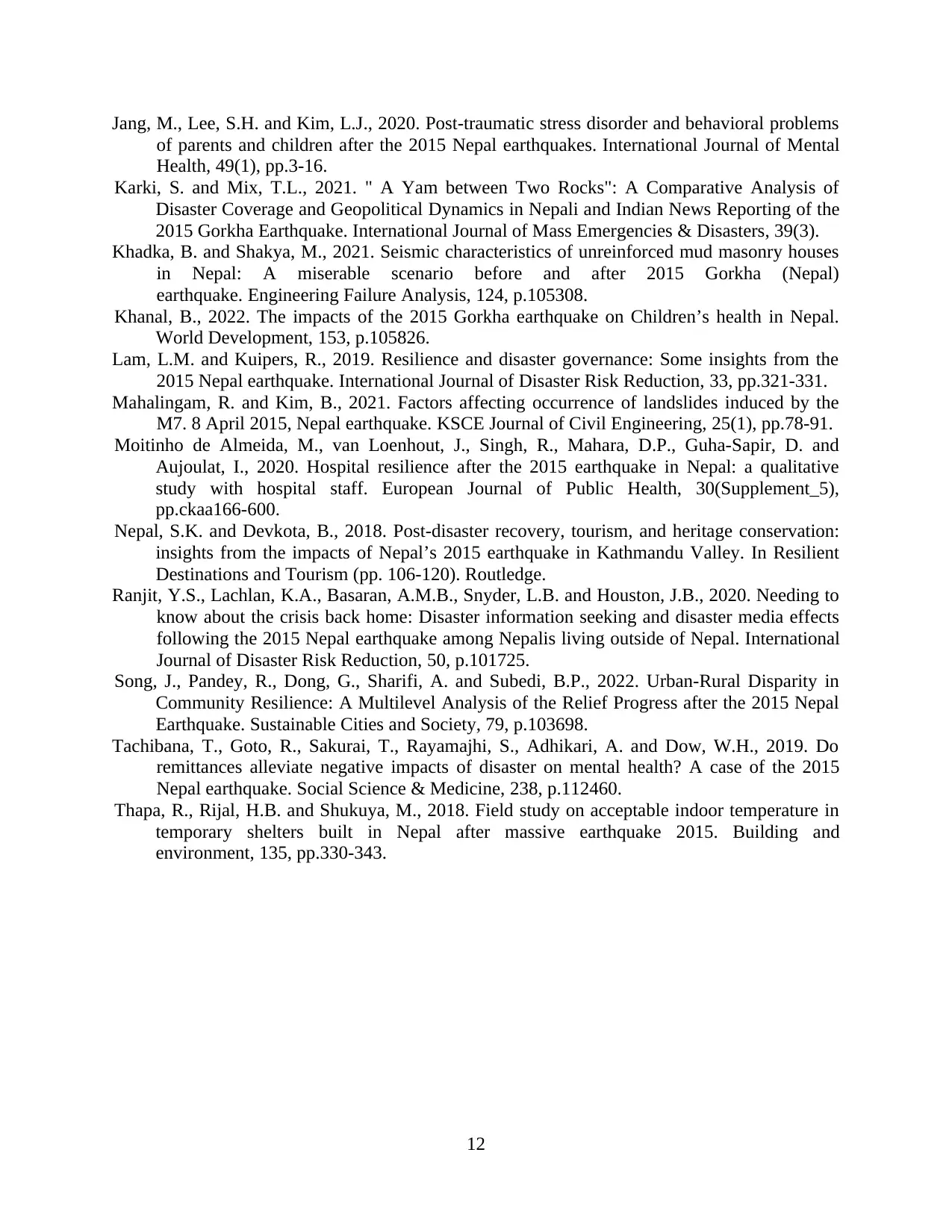
Jang, M., Lee, S.H. and Kim, L.J., 2020. Post-traumatic stress disorder and behavioral problems
of parents and children after the 2015 Nepal earthquakes. International Journal of Mental
Health, 49(1), pp.3-16.
Karki, S. and Mix, T.L., 2021. " A Yam between Two Rocks": A Comparative Analysis of
Disaster Coverage and Geopolitical Dynamics in Nepali and Indian News Reporting of the
2015 Gorkha Earthquake. International Journal of Mass Emergencies & Disasters, 39(3).
Khadka, B. and Shakya, M., 2021. Seismic characteristics of unreinforced mud masonry houses
in Nepal: A miserable scenario before and after 2015 Gorkha (Nepal)
earthquake. Engineering Failure Analysis, 124, p.105308.
Khanal, B., 2022. The impacts of the 2015 Gorkha earthquake on Children’s health in Nepal.
World Development, 153, p.105826.
Lam, L.M. and Kuipers, R., 2019. Resilience and disaster governance: Some insights from the
2015 Nepal earthquake. International Journal of Disaster Risk Reduction, 33, pp.321-331.
Mahalingam, R. and Kim, B., 2021. Factors affecting occurrence of landslides induced by the
M7. 8 April 2015, Nepal earthquake. KSCE Journal of Civil Engineering, 25(1), pp.78-91.
Moitinho de Almeida, M., van Loenhout, J., Singh, R., Mahara, D.P., Guha-Sapir, D. and
Aujoulat, I., 2020. Hospital resilience after the 2015 earthquake in Nepal: a qualitative
study with hospital staff. European Journal of Public Health, 30(Supplement_5),
pp.ckaa166-600.
Nepal, S.K. and Devkota, B., 2018. Post-disaster recovery, tourism, and heritage conservation:
insights from the impacts of Nepal’s 2015 earthquake in Kathmandu Valley. In Resilient
Destinations and Tourism (pp. 106-120). Routledge.
Ranjit, Y.S., Lachlan, K.A., Basaran, A.M.B., Snyder, L.B. and Houston, J.B., 2020. Needing to
know about the crisis back home: Disaster information seeking and disaster media effects
following the 2015 Nepal earthquake among Nepalis living outside of Nepal. International
Journal of Disaster Risk Reduction, 50, p.101725.
Song, J., Pandey, R., Dong, G., Sharifi, A. and Subedi, B.P., 2022. Urban-Rural Disparity in
Community Resilience: A Multilevel Analysis of the Relief Progress after the 2015 Nepal
Earthquake. Sustainable Cities and Society, 79, p.103698.
Tachibana, T., Goto, R., Sakurai, T., Rayamajhi, S., Adhikari, A. and Dow, W.H., 2019. Do
remittances alleviate negative impacts of disaster on mental health? A case of the 2015
Nepal earthquake. Social Science & Medicine, 238, p.112460.
Thapa, R., Rijal, H.B. and Shukuya, M., 2018. Field study on acceptable indoor temperature in
temporary shelters built in Nepal after massive earthquake 2015. Building and
environment, 135, pp.330-343.
12
of parents and children after the 2015 Nepal earthquakes. International Journal of Mental
Health, 49(1), pp.3-16.
Karki, S. and Mix, T.L., 2021. " A Yam between Two Rocks": A Comparative Analysis of
Disaster Coverage and Geopolitical Dynamics in Nepali and Indian News Reporting of the
2015 Gorkha Earthquake. International Journal of Mass Emergencies & Disasters, 39(3).
Khadka, B. and Shakya, M., 2021. Seismic characteristics of unreinforced mud masonry houses
in Nepal: A miserable scenario before and after 2015 Gorkha (Nepal)
earthquake. Engineering Failure Analysis, 124, p.105308.
Khanal, B., 2022. The impacts of the 2015 Gorkha earthquake on Children’s health in Nepal.
World Development, 153, p.105826.
Lam, L.M. and Kuipers, R., 2019. Resilience and disaster governance: Some insights from the
2015 Nepal earthquake. International Journal of Disaster Risk Reduction, 33, pp.321-331.
Mahalingam, R. and Kim, B., 2021. Factors affecting occurrence of landslides induced by the
M7. 8 April 2015, Nepal earthquake. KSCE Journal of Civil Engineering, 25(1), pp.78-91.
Moitinho de Almeida, M., van Loenhout, J., Singh, R., Mahara, D.P., Guha-Sapir, D. and
Aujoulat, I., 2020. Hospital resilience after the 2015 earthquake in Nepal: a qualitative
study with hospital staff. European Journal of Public Health, 30(Supplement_5),
pp.ckaa166-600.
Nepal, S.K. and Devkota, B., 2018. Post-disaster recovery, tourism, and heritage conservation:
insights from the impacts of Nepal’s 2015 earthquake in Kathmandu Valley. In Resilient
Destinations and Tourism (pp. 106-120). Routledge.
Ranjit, Y.S., Lachlan, K.A., Basaran, A.M.B., Snyder, L.B. and Houston, J.B., 2020. Needing to
know about the crisis back home: Disaster information seeking and disaster media effects
following the 2015 Nepal earthquake among Nepalis living outside of Nepal. International
Journal of Disaster Risk Reduction, 50, p.101725.
Song, J., Pandey, R., Dong, G., Sharifi, A. and Subedi, B.P., 2022. Urban-Rural Disparity in
Community Resilience: A Multilevel Analysis of the Relief Progress after the 2015 Nepal
Earthquake. Sustainable Cities and Society, 79, p.103698.
Tachibana, T., Goto, R., Sakurai, T., Rayamajhi, S., Adhikari, A. and Dow, W.H., 2019. Do
remittances alleviate negative impacts of disaster on mental health? A case of the 2015
Nepal earthquake. Social Science & Medicine, 238, p.112460.
Thapa, R., Rijal, H.B. and Shukuya, M., 2018. Field study on acceptable indoor temperature in
temporary shelters built in Nepal after massive earthquake 2015. Building and
environment, 135, pp.330-343.
12
1 out of 14
Your All-in-One AI-Powered Toolkit for Academic Success.
+13062052269
info@desklib.com
Available 24*7 on WhatsApp / Email
![[object Object]](/_next/static/media/star-bottom.7253800d.svg)
Unlock your academic potential
© 2024 | Zucol Services PVT LTD | All rights reserved.

